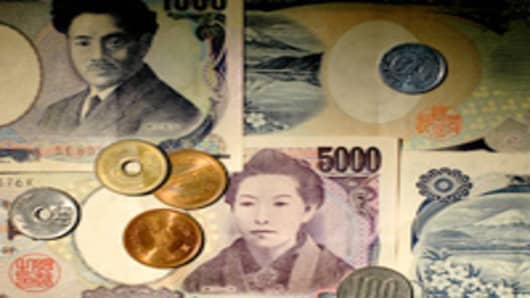It was already shaping up to be an unusual and dynamic year for the currency market, when the nuclear crisis in Japancaused a startling spike in the yen.
After all, its not very often that three of the world's major currencies—the U.S. Dollar, British Pound and the Euro —display simultaneous weakness, while a handful of currencies from commodities-richnations — the Australian and Canadian dollars, Brazilian Real and Norwegian Krone—show widespread strength. Then, there's the appreciating currencies of emerging markets, which continue to attract hot money.
On top of that there are powerful policy initiatives at work—from the Federal Reserve's QE2 monetary stimulus to Europe's belt-tightening—as well as the usual guessing game about which central banks will raise interest rates first.
Put together, it makes for lots of opportunities for new currency pairs andcross-rate plays —and with a new generation of low-cost, online currency trading platforms, retail investors can play the world currency stage.
You'll need to know a bit about monetary policy and economic fundamentals.And you need to know the risks. With that in mind, here's some background on the market and the major currencies.
The Playing Field
With U.S. interest ratesat virtually zero and a ballooning budget deficit, the dollar is weak, making other G7 as well as emerging-market currencies more attractive.
“We’re concerned the fiscal backdrop in the US is not being addressed in a credible way," says Robert Lynch, head of currency strategy for HSBC, and one of the many who is bearish on the dollar. "Foreign investors are holding a great deal of our debt, and they may become concerned about the United States' ability to repay, in a way that will potentially weigh on the dollar this year.”
Japan was already struggling to contain the yen's appreciation against the dollar when the nuclear crisis erupted, which gave it a further boost against the American currency as well as other major ones.
Citigroup's senior G10 foreign exchange strategist Greg Anderson is expecting a weak yen in the medium term, which he says would be good for Japan’s recovery, and good for G10/yen pairs.
“I believe Japan will ultimately defend the 80 level with intervention," says Anderson. "[The]dollar-yen [level] has been in the low 80s for over six months—which is a critical level, because it’s an all-time low. What’s best for [Japan's] economy is a weaker yen. If they see the yen strengthen they will intervene. In a panic, the yen strengthens. So officials are making yen plentiful, instead of scarce. If the price of yen goes down, Euro/yen and dollar/yen plays go up. It should be positive for the G10,” says Anderson.
Handful Of Favorites
Steven Englander, head of the G10 foreign exchange team at Citigroup, says his first choice is the British Pound Sterling.
“We’ve been bullish on sterling for last two months. We’ve come from $1.55 [vs. the dollar] to $1.63 this year. That’s a nice rally. We expect it to get to $1.70 by the end of this year. The next move will occur in the second quarter.”
Englander is also predicting sustained economic recovery in the U.K.
“They’ve done a lot of things the U.S. has been too scared to do. Last year they raised taxes and laid off government workers. They dared do it — and their economy will turn out just fine despite headwinds — but the market will have to see that before we’ll see the $1.70 target.”
In contrast, no one seems convinced that the Eurozone’s sovereign debt crisis is in the past.
Brian Kim, foreign exchange strategist at UBS, is bearish on the Euro, especially given recent remarks by European Central Bank President Jean-Claude Trichet’s indicating a rate hike is near.
“They’re signaling an April move," says Kim. "We’re looking for 25 basis points [a quarter percentage point] for the first move. The market is supportive for the near term. But the sovereign debt problem is still an issue. These countries need to clamp down on their budget deficits. We prefer not to play this currency. It has the support of a hawkish central bank, but we think that after a couple months pass, the initial euphoria will taper down,” Kim adds.
Then, there's the so-called commodities-driven currencies of countries rich in natural resources, from grains to metals to fossil fuels: Canada, Norway, Brazil, Australia, for instance.
“Norway has our favorite currency because it has the best fiscal position among developed economies," says HSBC’s Robert Lynch. "It hasn’t appreciated anywhere near the extent to which other commodity currencies have, like the Australian dollar. And certainly the recent rise in price of oil has the potential to support Norway. We see the others as either fully, or overvalued.”
Trading Platforms
Citigroup’s Anderson sees the Canadian dollar is No. 1, followed by the Norwegian Krone and Australian dollar.
“They are a secure producer of oil," he says. "It should make their product very attractive with prices up. On top of that, you had a central bank that paused rates because of QE2. Now, the central bank is segueing into a rate hike in the second quarter. It’s a bullish factor in addition to oil.”
That said, there's also a fair amount of psychology involved in the currency markets. That along with momentum often lead to price moves that are overdone, and quickly reversed.
How to Get In
Online platforms like FXCM.com, FOREX.com and CitiFxPro.com offer retail investors the ability to trade the full spectrum of global currencies.
Importantly, these platforms allow investors to create different currency crosses without playing the U.S. dollar.
Englander of Citigroup offers advice: “Only bullish on sterling? Buy one unit of sterling, sell one unit of Euro—and you’ve created a cross rate synthetically. It’s a much cleaner, easier route."
A "cross-rate" refers to a currency trade contract that does not involve the U.S. dollar. If you want to trade Euro/Yen, for example, a U.S. investor would normally need to trade two positions: Euro/USD and Yen/USD. Separate positions are separate transactions, each requiring their own 'margin', industry jargon for deposit. A cross rate allows you to trade currency pairs in one single transaction, and pay one single margin.
Bear in mind, account minimums range widely. CitiFXPro is the Cadillac version, with a minimum of $10,000 or equivalent in a number of other currencies, while Compare FXCM offering "micro” account access for $50.
The fee structure for these online platforms, however, is uniform. While many brokers will charge a markup on the spread in addition to a monthly fee for using their platform, FXCM and CitiFXPro charge fees only on a per-trade basis.
The spread, known as the cost to trade, determines your fee. It is the difference between the bid and the ask, which you are always able to see before you trade.
For example, FXCM's markup on the spread for the "micro lot" ($1,000) trade is 10 cents. For a "mini lot," or standard $10,000 account, the charge is $1.00.
The industry term for this fee is called a PIP, or point in percentage, which is a point system for calculating profits and losses. For CitiFXPro, on a $100,00 Euro/dollar trade, 1 PIP is equal to $10. So the PIP on their 1.6 spread is $16. Spreads are determined by the vendor, so compare them before opening an account.
If you want to avoid account minimums and doing your own trading, try exchange-traded funds, ETFs, and exchange traded notes, ETNs, which offer easy diversification to foreign currencies, and trade just like a stock in your brokerage account.
There are some six dozen currency ETFs. Less than half are U.S. listed
CurrencyShares, for instance, offers almost a dozen, dealing in both major and lesser ones, including the Swiss Franc, Mexican Peso and Russian Ruble. PowerShares, ProShares, MarketVector, Barclays and WidsomTree are also very active in the field.
Barclays' iPath offers four ETNs linked to three currencies (Pound, Euro, Yen). iPath and Market Vectors also offer ETNs.
Be sure to check with your accountant about taxation differences between ETNs and ETFs.
ETFs and ETNs are the simple way of accessing foreign exchange, but cover a limited—if growing—number of currencies.
A more dedicated foreign exchange investor will need to open an account with one of the major brokerage firms like FXCM. These firms recommend that you start with a practice account to learn the ins and outs of the foreign exchange markets before you put your investment capital to work.
Currencies trade virtually 24 hours a day and the market moves at lightning speed. Price swings can be swift, large and unexpected.



